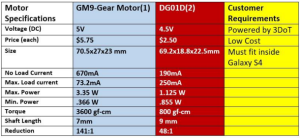Spring 2016 3DOT Goliath DC Motor Trade-Off Study
By: Kevin Moran (Electronics and Control Engineer)
After carefully reviewing motors on the market, the two motors presented above were selected; the GM9-Gear and DG1D motors. These two motors are very easy to obtain and the price is within our cost margins. They require a voltage output that is within the capabilities of the 3DoT board to support. The preliminary design of the rover puts the mass at 680 grams. The specifications of motor DG1D is the best match for our level 1 and level 2 requirements. A level 1 requirement of having the rover be as small as an Android phone led to the selection of the Samsung Galaxy S4 size as the size of the body. This selection capped the mass of the rover at under 800 grams. Motor 2 has the torque required to power our rover, as opposed to Motor 1 whose torque is over 4 times the necessary amount. This torque forces Motor 2 to require 3 times more Wattage than Motor 1. With the Wattage that is being saved by selection Motor 2, we will be able to power the laser and receiver and consume less battery life. Motor 1 has a higher RPM value, and while our torque is sufficient to move our rover; this will give it a faster speed than Motor 2 will. The 3DoT board’s power is regulated and is stepped up from 3.7 V to 5.0 V (600 mA max) Voltage Booster (TI TPS61200) which will power the motors.
By the way, the 3DoT board uses Motor Driver – Dual TB6612FNG allowing us to independently control the two motors.
Sources:
https://www.sparkfun.com/products/13302
http://www.robotshop.com/blog/en/how-do-i-interpret-dc-motor-specifications-3657
https://docs.google.com/document/d/1uzrTbrNunatROhcL7kHwnHCf-x88XjqA9n1831kP274/edit#

